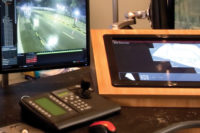
Dave Shearer, an Armida Technologies engineer, installs a patch antenna for the wireless video system at Holt Caterpillar, San Antonio.
Holt Caterpillar, located on the southeast side of San Antonio, has built a reputation as the largest dealer of the familiar yellow earth-moving and agricultural machinery equipment in the United States.
Holt started in business on South Flores St. in 1933, and moved to its current location off Loop 13 in 1957. At the time, the facility was located well outside the San Antonio city limits. Times have changed.
Today, the San Antonio city limits extend far beyond Holt’s facilities. This urban growth, combined with the increased value of equipment and parts inventories, played a factor in the dealership’s consideration of viable security solutions.
Installing a traditional wired analog or IP-based security system would have cost the Caterpillar franchise a great deal of money, time and effort for the wiring and conduit to protect its assets and resources, especially with the expansion and addition of new warehouses and facilities.
Armida Technologies of San Antonio helped the heavy equipment distributor to devise a more cost-effective, easily deployed, wireless-based security solution to monitor its multi-million-dollar inventory.
“Can you imagine the costs of putting in IP-based Category 6 wiring and the trenching needed to protect that cabling from one building to the headquarters?” asks Dave Shearer, an Armida engineer, pointing to a distance that looks like the size of the nearby AT&T Center, home of the San Antonio Spurs.
“We want to get away from the costs of hard wiring,” insists Thomas Murray, vice president of information technology at Holt Caterpillar. “We want the ease of set-up and delivery without compromising reliability while addressing our security needs. The Armida solution meets our needs.”
The Holt project has become a showcase for how Armida’s initial product, the SecurityController featuring Videlity software, can improve the reliability of surveillance video from a wireless platform.
“We have enhanced the industry-standard 802.11a/b/g, 900 MHz, 802.16, and 4.9 GHz wireless technology with our software to monitor the Holt base of operations,” explains Matt Reedy, Armida’s chief technology officer.

A variety of views are available of Holt Caterpillar, San Antonio, based on the wireless video system from Armida Technologies of San Antonio.
“In extreme cases, it can cause jerkiness or even stop the video completely — it all depends on the strength of the other signals,” Lawrence explains. “However, our software overcomes those issues by encapsulating the video before it is transmitted.”
His company uses industry-standard AES encryption and MPEG-4 compression to provide video streaming rates at up to 30 frames per second.
Reedy asserts that tests have shown that with line-of-sight between radio antennas, the company can send a clear video signal from a camera located five miles away.
“Even with all of the other forms of interference, we have shown that we can provide a high-quality video stream that could help Holt and our other customers see the critical details in surveillance video — a person’s face or the license plate of a vehicle,” Reedy insists.
The device can take video input from up to four analog and four digital video cameras, RS-485 access control devices or alarm system inputs.
At Holt, Armida’s engineers record the video surveillance information onto a Dell computer with 180 gigabytes of storage. Each camera requires between one and three gigabytes of storage daily.
Holt executives have told Armida’s management team that they like the quality of the video and the flexibility of the convergence platform.
“It’s been very easy for our engineers to move a camera or add a location,” notes Sloan Foster, Armida’s chief marketing officer. “Once Holt’s management team saw how easy it was to add a camera, they asked us to install additional cameras near cash registers in the parts department to record transactions.”
Sidebar: On The Job
- SecurityController featuring Videlity software from Armida Technologies of San Antonio, www.armidatechnologies.com
- Dell computer with 180 gigabytes of storage
- 3 MDI video cameras

Sidebar: PROJECTS in the News
Wanco Inc., a manufacturer of highway and traffic control products, choseVicon Industries Inc., Hauppauge, N.Y., to provide cameras for Wanco’s portable surveillance units. These compact, self-contained units provide rapidly deployable solutions for temporary remote surveillance needs. Up to four Vicon SurveyorVFT 23x day/night camera domes are mounted atop a 26-foot telescoping tower attached to a portable trailer body. The tower collapses and folds to a horizontal position over the trailer body for towing. When deployed, the cameras on the portable units provide high-resolution surveillance video that may be monitored via wireless communication from either a central monitoring station or from any computer with Internet connection and loaded with Wanco’s client software. Camera functions, including pan, tilt and zoom, can be controlled from the monitoring location.â– â– â–
High-resolution bullet cameras fromRainbow CCTV/ISO, Costa Mesa, Calif., are being used for security monitoring and license plate recognition at the vehicle terminal serving Europe’s busiest port, Dover, in the United Kingdom. The color DSP bullet camera, a 1/3 inch unit which offers 480 TV lines resolution and uses a Sony Super HAD CCD, allows police to observe freight and car traffic at the Eurotunnel plaza in Folkestone, which connects with the M20 motorway.Tyco Fire and Integrated Solutionscreated an application using DVRs fromVirage, who were involved at an early stage and developed the necessary protocols.
â– â– â–
Clemson University’s livestock poultry health programs in Columbia, S.C., installed ACS WebService fromBrivo Systems LLC, Bethesda, Md., to ensure full access control to four agricultural departments. The system controls five exterior doors and several interior doors to divide access areas within the building. Full lockdown is ensured and visitors can be sent to the main entrance lobby to provide audit trails for deliveries and samples sent to the laboratory.
â– â– â–
Viscount Systems Inc., Burnaby, British Columbia, received a commitment for its single largest MESH order to date for a three-phase project in Vancouver. The first phase completion will be in 2008 and the balance scheduled by 2009. Revenue for equipment and commissioning for each phase is approximately $180,000 for a total of just over $500,000. The facilities will be deploying a full complement of technology including voice panels, LANBot card access, alarms, voice communications technology and video recording and storage.





